
Manihot esculenta, commonly called cassava, manioc, or yuca, is a woody shrub of the spurge family, Euphorbiaceae, native to South America, from Brazil and parts of the Andes. Although a perennial plant, cassava is extensively cultivated as an annual crop in tropical and subtropical regions for its edible starchy root tuber, a major source of carbohydrates. Cassava is predominantly consumed in boiled form, but substantial quantities are used to extract cassava starch, called tapioca, which is used for food, animal feed, and industrial purposes. The Brazilian farinha, and the related garri of West Africa, is an edible coarse flour obtained by grating cassava roots, pressing moisture off the obtained grated pulp, and finally drying it.
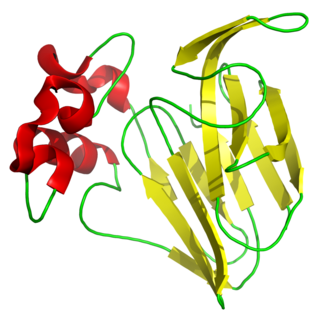
Thaumatin is a low-calorie sweetener and flavor modifier. The protein is often used primarily for its flavor-modifying properties and not exclusively as a sweetener.

Momordica charantia is a tropical and subtropical vine of the family Cucurbitaceae, widely grown in Asia, Africa, and the Caribbean for its edible fruit. Its many varieties differ substantially in the shape and bitterness of the fruit.
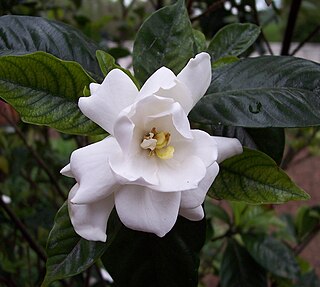
Gardenia is a genus of flowering plants in the coffee family, Rubiaceae, native to the tropical and subtropical regions of Africa, Asia, Madagascar, Pacific Islands, and Australia.

Monellin, a sweet protein, was discovered in 1969 in the fruit of the West African shrub known as serendipity berry ; it was first reported as a carbohydrate. The protein was named in 1972 after the Monell Chemical Senses Center in Philadelphia, U.S.A., where it was isolated and characterized.

The winged bean, also known as cigarillas, goa bean, four-angled bean, four-cornered bean, manila bean, princess bean, star bean, kamrangi bean, pea, dragon bean, is a tropical herbaceous legume plant.

Lablab purpureus is a species of bean in the family Fabaceae. It is native to sub-Saharan Africa and India and it is cultivated throughout the tropics for food. English language common names include hyacinth bean, lablab-beanbonavist bean/pea, dolichos bean, seim or sem bean, lablab bean, Egyptian kidney bean, Indian bean, bataw and Australian pea. It is the only species in the monotypic genus Lablab.
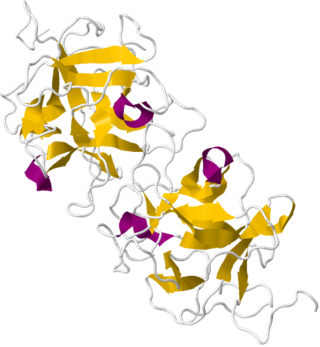
Miraculin is a taste modifier, a glycoprotein extracted from the fruit of Synsepalum dulcificum. The berry, also known as the miracle fruit, was documented by explorer Chevalier des Marchais, who searched for many different fruits during a 1725 excursion to its native West Africa.

Synsepalum dulcificum is a plant in the Sapotaceae family, native to tropical Africa. It is known for its berry that, when eaten, causes sour foods subsequently consumed to taste sweet. This effect is due to miraculin. Common names for this species and its berry include miracle fruit, miracle berry, miraculous berry, sweet berry, and in West Africa, where the species originates, agbayun, taami, asaa, and ledidi.
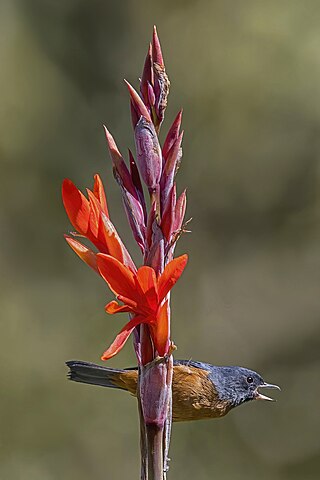
Canna indica, commonly known as Indian shot, African arrowroot, edible canna, purple arrowroot, Sierra Leone arrowroot, is a plant species in the family Cannaceae. It is native to much of South America, Central America, the West Indies, and Mexico. It is also naturalized in the southeastern United States, and much of Europe, sub-Saharan Africa, Southeast Asia, and Oceania.

Yam is the common name for some plant species in the genus Dioscorea that form edible tubers. The tubers of some other species in the genus, such as D. communis, are toxic. Yams are perennial herbaceous vines cultivated for the consumption of their starchy tubers in many temperate and tropical regions, especially in West Africa, South America and the Caribbean, Asia, and Oceania. The tubers themselves, also called "yams", come in a variety of forms owing to numerous cultivars and related species.

Lupinus albus, commonly known as the white lupin or field lupine, is a member of the genus Lupinus in the family Fabaceae. It is a traditional pulse cultivated in the Mediterranean region.
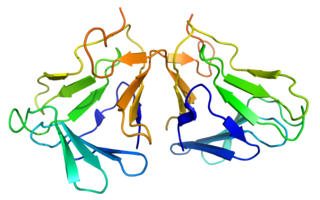
Curculin or neoculin is a sweet protein that was discovered and isolated in 1990 from the fruit of Curculigo latifolia (Hypoxidaceae), a plant from Malaysia. Like miraculin, curculin exhibits taste-modifying activity; however, unlike miraculin, it also exhibits a sweet taste by itself. After consumption of curculin, water and sour solutions taste sweet. The plant is referred to locally as 'Lumbah' or 'Lemba'.

Pentadiplandra brazzeana is an evergreen shrub or liana that is the only species assigned to the genus Pentadiplandra, and has been placed in a family of its own called Pentadiplandraceae. It produces large red berries, sometimes mottled with grey. It is known from West-Central Tropical Africa, between northern Angola, eastern Nigeria and western Democratic Republic of Congo. The berry is sweet in taste due to the protein, brazzein, which is substantially sweeter than saccharose. Brazzein may be useful as a low-calorie sweetener, but is not yet allowed as a food additive in the United States and the European Union.

Pentadin, a sweet-tasting protein, was discovered and isolated in 1989, in the fruit of oubli, a climbing shrub growing in some tropical countries of Africa. Sweet tasting proteins are often used in the treatment of diabetes, obesity, and other metabolic disorders that one can experience. These proteins are isolated from the pulp of various fruits, typically found in rain forests and are also used as low calorie sweeteners that can enhance and modify existing foods.

Thaumatococcus daniellii, also known as miracle fruit or miracle berry, is a plant species from tropical Africa of the Marantaceae family. It is a large, rhizomatous, flowering herb native to the rainforests of western Africa in Sierra Leone, southeast to Gabon and the Democratic Republic of the Congo. It is also an introduced species in Australia and Singapore.

Neustanthus is a monotypic genus of flowering plants belonging to the pea family Fabaceae and its tribe Phaseoleae. The only species is Neustanthus phaseoloides, called tropical kudzu. This species is a forage crop and cover crop used in the tropics. It is known as puero in Australia and tropical kudzu in most tropical regions.

Combretum hereroense, commonly known as the russet bushwillow and the mouse-eared combretum, is a deciduous shrub or small tree that is found from eastern Africa to northern South Africa. Over its extensive range it is variable with respect to leaf shape, fruit size and indumentum.
Volkensin is a eukaryotic ribosome-inactivating protein found in the Adenia volkensii plant. It is a glycoprotein with two subunits A and B. A subunit is linked to B subunit with disulfide bridges and non-covalent bonds. B subunit is responsible for binding to the galactosyl-terminated receptors on the cell membrane that allows the entry the A subunit of the toxin into the cell, which performs the inhibitory function. Volkensin is a galactose specific lectin that can inhibit protein synthesis in whole cells and in cell-free lysates. This protein can be included into the category of risin like toxins and it resembles modeccin, the toxin of Adenia digitata. Although very similar in composition, volkensin contains more cysteine residues and more than twice as much sugar than modeccin, due to high content of galactose and mannose. In addition, volkensin is able to inhibit protein synthesis at concentrations 10 times lower than required for modeccin. From gene sequencing analysis, volkensin was found to be coded by 1569-bp ORF, that is 523 amino acid residues without introns. The internal linker sequence is 45 bp. The active site of the A subunit contains Ser203, a novel residue that is conserved in all ribosome inactivating proteins.

Gardenia volkensii, commonly known as bushveldt gardenia or Transvaal gardenia, is a species of plant in the family Rubiaceae native to southern Africa.


















